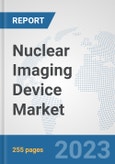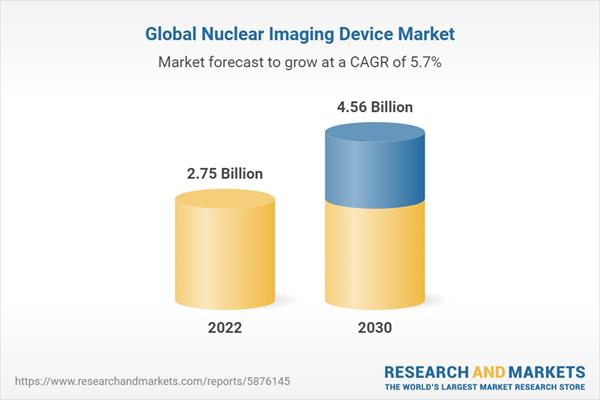The report on the global nuclear imaging device market provides qualitative and quantitative analysis for the period from 2021-2030. The global nuclear imaging device market was valued at USD 2.75 billion in 2022 and is expected to reach USD 4.56 billion in 2030, with a CAGR of 5.71% during the forecast period 2023-2030. The study on nuclear imaging device market covers the analysis of the leading geographies such as North America, Europe, Asia Pacific, and RoW for the period of 2021-2030.
The demand for nuclear imaging devices is driven by the increasing prevalence of chronic diseases such as cancer, cardiovascular disorders, and neurological conditions, requiring early detection and effective management. Advancements in imaging technologies have improved diagnostic capabilities, appealing to healthcare providers and patients. The growing aging population also fuels the demand for age-related health conditions diagnosis and monitoring. Screening programs and awareness contribute to device demand. Additionally, personalized medicine and research efforts in radiotracers, hybrid systems, and AI image analysis drive market growth. Factors such as healthcare expenditure, government support, and medical tourism contribute to the demand. The COVID-19 pandemic emphasizes the importance of accurate medical imaging, further propelling device adoption.
The global nuclear imaging device market is bifurcated by product type, by application, and end user. By product type, the segment is further bifurcated into (Positron Emission Computed Tomography (PET), Single Photon Emission Computed Tomography (SPECT), Planar Scintigraphy, and Hybrid Systems is further segmented into SPECT/CT and PET/CT. The Positron Emission Computed Tomography (PET) segment is expected to continue its dominant position in the nuclear imaging device market in 2023. The extensive adoption of PET imaging arises from its unique capability to unveil crucial insights into metabolic processes that are vital for efficient cancer management. This pivotal capability, which customizes treatments for positive outcomes, holds particular importance in oncology due to PET's sensitive diagnostic, staging, and treatment monitoring abilities. As global cancer rates rise, the demand for precise diagnostics increases, making PET's accuracy in identifying metabolic activity priceless for early detection and precise treatment tracking.
Additionally, with healthcare embracing personalized medicine, PET's capacity to provide tailored insights into metabolic activity gains prominence. This resonates with personalized treatment strategies, further highlighting PET's crucial role in modern healthcare. In essence, the demand for PET imaging devices arises from their potential to reshape cancer management by offering comprehensive insights and personalized care.
The global nuclear imaging device market is segmented into Asia Pacific, North America, Europe, the Middle East & Africa, and South America. North America is dominating the global market share. A robust healthcare infrastructure characterized by cutting-edge medical establishments and research hubs is possessed by North America. The acceptance and application of nuclear imaging technologies are significantly fostered by this framework. As per the International Trade Centre (ITC), North America held the position of the primary exporter and importer of medical devices in 2022. Moreover, active engagement in research and innovation is stood out in North America. Substantial resources toward advancing nuclear imaging methods are allocated by prominent medical research institutions, pharmaceutical enterprises, and healthcare entities in the region. This commitment plays a pivotal role in propelling the market expansion and driving pioneering developments.
2. Internal and External subject matter experts
3. Professionals and participants from the industry
2. Product/brand/marketing managers
3. CXO level executives
4. Regional/zonal/country managers
5. Vice President level executives.
2. Government/institutional publications
3. Trade and associations journals
4. Databases such as WTO, OECD, World Bank, and among others.
5. Websites and publications by research agencies
2. Complete coverage of all the segments in the nuclear imaging device market to analyze the trends, developments in the global market and forecast of market size up to 2030.
3. Comprehensive analysis of the companies operating in the global nuclear imaging device market. The company profile includes analysis of product portfolio, revenue, SWOT analysis and latest developments of the company.
4. Growth Matrix presents an analysis of the product segments and geographies that market players should focus to invest, consolidate, expand and/or diversify.
The demand for nuclear imaging devices is driven by the increasing prevalence of chronic diseases such as cancer, cardiovascular disorders, and neurological conditions, requiring early detection and effective management. Advancements in imaging technologies have improved diagnostic capabilities, appealing to healthcare providers and patients. The growing aging population also fuels the demand for age-related health conditions diagnosis and monitoring. Screening programs and awareness contribute to device demand. Additionally, personalized medicine and research efforts in radiotracers, hybrid systems, and AI image analysis drive market growth. Factors such as healthcare expenditure, government support, and medical tourism contribute to the demand. The COVID-19 pandemic emphasizes the importance of accurate medical imaging, further propelling device adoption.
The global nuclear imaging device market is bifurcated by product type, by application, and end user. By product type, the segment is further bifurcated into (Positron Emission Computed Tomography (PET), Single Photon Emission Computed Tomography (SPECT), Planar Scintigraphy, and Hybrid Systems is further segmented into SPECT/CT and PET/CT. The Positron Emission Computed Tomography (PET) segment is expected to continue its dominant position in the nuclear imaging device market in 2023. The extensive adoption of PET imaging arises from its unique capability to unveil crucial insights into metabolic processes that are vital for efficient cancer management. This pivotal capability, which customizes treatments for positive outcomes, holds particular importance in oncology due to PET's sensitive diagnostic, staging, and treatment monitoring abilities. As global cancer rates rise, the demand for precise diagnostics increases, making PET's accuracy in identifying metabolic activity priceless for early detection and precise treatment tracking.
Additionally, with healthcare embracing personalized medicine, PET's capacity to provide tailored insights into metabolic activity gains prominence. This resonates with personalized treatment strategies, further highlighting PET's crucial role in modern healthcare. In essence, the demand for PET imaging devices arises from their potential to reshape cancer management by offering comprehensive insights and personalized care.
The global nuclear imaging device market is segmented into Asia Pacific, North America, Europe, the Middle East & Africa, and South America. North America is dominating the global market share. A robust healthcare infrastructure characterized by cutting-edge medical establishments and research hubs is possessed by North America. The acceptance and application of nuclear imaging technologies are significantly fostered by this framework. As per the International Trade Centre (ITC), North America held the position of the primary exporter and importer of medical devices in 2022. Moreover, active engagement in research and innovation is stood out in North America. Substantial resources toward advancing nuclear imaging methods are allocated by prominent medical research institutions, pharmaceutical enterprises, and healthcare entities in the region. This commitment plays a pivotal role in propelling the market expansion and driving pioneering developments.
Report Findings
1) Drivers
- The rising prevalence of cancer, cardiovascular diseases, and neurological disorders fuels the demand for nuclear imaging devices. These devices play a crucial role in early diagnosis and effective treatment planning.
- Rising healthcare expenditure across the globe is driving the market growth.
2) Restraints
- The initial cost of acquiring and maintaining nuclear imaging devices can be prohibitive for some healthcare facilities, limiting their adoption, especially in resource-constrained regions.
3) Opportunities
- Integration of ai algorithms in nuclear imaging devices can enhance image analysis, improve diagnostic accuracy, and streamline workflows.
Research Methodology
A) Primary Research
The primary research involves extensive interviews and analysis of the opinions provided by the primary respondents. The primary research starts with identifying and approaching the primary respondents.The primary respondents are approached include
1. Key Opinion Leaders2. Internal and External subject matter experts
3. Professionals and participants from the industry
The primary research respondents typically include
1. Executives working with leading companies in the market under review2. Product/brand/marketing managers
3. CXO level executives
4. Regional/zonal/country managers
5. Vice President level executives.
B) Secondary Research
Secondary research involves extensive exploring through the secondary sources of information available in both the public domain and paid sources. Each research study is based on over 500 hours of secondary research accompanied by primary research. The information obtained through the secondary sources is validated through the crosscheck on various data sources.The secondary sources of the data typically include
1. Company reports and publications2. Government/institutional publications
3. Trade and associations journals
4. Databases such as WTO, OECD, World Bank, and among others.
5. Websites and publications by research agencies
Segment Covered
The global nuclear imaging device market is segmented on the basis of by product type, application, and end user.The Global Nuclear Imaging Device Market by Product Type
- Positron Emission Computed Tomography (PET)
- Single Photon Emission Computed Tomography (SPECT)
- Planar Scintigraphy
- Hybrid Systems
- SPECT/CT
- PET/CT
The Global Nuclear Imaging Device Market by Application
- Oncology
- Cardiology
- Neurology
- Orthopedics
- Others
The Global Nuclear Imaging Device Market by End User
- Hospitals
- Diagnostic Imaging Centers
- Research Institutes
- Others
Company Profiles
The companies covered in the report include- Siemens Healthcare GmbH
- GE HealthCare
- Koninklijke Philips N.V.
- CANON MEDICAL SYSTEMS CORPORATION
- Mediso Ltd.
- DIGIRAD HEALTH, INC.
- SurgicEye GmbH
- Spectrum Dynamics Medical
- DDD-Diagnostic A/S
- CMR Naviscan
What does this Report Deliver?
1. Comprehensive analysis of the global as well as regional markets of the nuclear imaging device market.2. Complete coverage of all the segments in the nuclear imaging device market to analyze the trends, developments in the global market and forecast of market size up to 2030.
3. Comprehensive analysis of the companies operating in the global nuclear imaging device market. The company profile includes analysis of product portfolio, revenue, SWOT analysis and latest developments of the company.
4. Growth Matrix presents an analysis of the product segments and geographies that market players should focus to invest, consolidate, expand and/or diversify.
Table of Contents
Chapter 1. Preface
Chapter 2. Executive Summary
Chapter 3. Global Nuclear Imaging Device Market Overview
Chapter 5. Company Profiles and Competitive Landscape
Chapter 6. Global Nuclear Imaging Device Market by Product Type
Chapter 7. Global Nuclear Imaging Device Market by Application
Chapter 8. Global Nuclear Imaging Device Market by End User
Chapter 9. Global Nuclear Imaging Device Market by Region 2023-2030
Companies Mentioned
- Siemens Healthcare GmbH
- GE HealthCare
- Koninklijke Philips N.V.
- CANON MEDICAL SYSTEMS CORPORATION
- Mediso Ltd.
- DIGIRAD HEALTH, INC.
- SurgicEye GmbH
- Spectrum Dynamics Medical
- DDD-Diagnostic A/S
- CMR Naviscan
Table Information
| Report Attribute | Details |
|---|---|
| No. of Pages | 255 |
| Published | August 2023 |
| Forecast Period | 2022 - 2030 |
| Estimated Market Value in 2022 | 2.75 Billion |
| Forecasted Market Value by 2030 | 4.56 Billion |
| Compound Annual Growth Rate | 5.7% |
| Regions Covered | Global |
| No. of Companies Mentioned | 10 |









